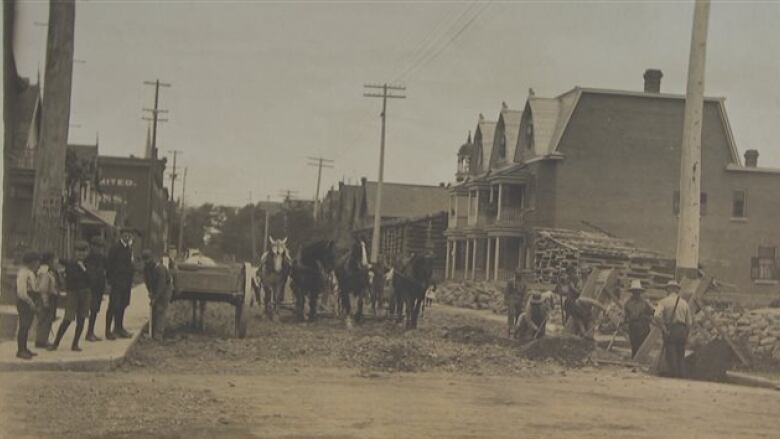LeBreton Flats revisited: newest visions just latest chapters in storied history
Not the first time former 'slum' has been focus of developers' plans, historian says

The focus this week is on the future of LeBreton Flats, but one Ottawa urban historian is advising us to look tothepast for guidance on the redevelopment.
The site, just west of downtown Ottawa, has been opened up for redevelopment by the National Capital Commission, which has chosen two finalists to build on 9.3 hectares of land.
Those two bidderswill reveal their full proposals during a public consultation at the Canadian War Museum starting Tuesday at 4 p.m.
- LeBreton Flats redevelopment down to 2 proposals
- LeBreton Flats DCDLS bid includes underground arena, 'Brewseum'
- LeBreton Flats redevelopment proposals 'not similar at all,' NCC boss says
Robert Smythe, an urban historian with experience as a planner and political staffer, said in an interview with Radio-Canada the site's development dates back to the turn of the 19th century.
"That's where the settlers first landed, that's where the Rideau Canal was going to open up at first, so really that's the earliest part of Ottawa that's where the city was born," he said.

The great fire
The area filledup with stone buildings, mills, hotels and some rail lines by the time a fire completely destroyed the community in 1900.
"It started one April morning in 1900 in Hull and it spread across the [Ottawa River] veryquickly, it was quite windy. Because of all the lumber industry and piles of wood and sawdust it spread really within a matter of hours," he said.
"[LeBreton Flats] was pretty well totally wiped out, it was burnt to a cinder just some melted steel and melted cars. So they had to start over."

Smythe said the community was rebuilt in three years and became much more industrial, with around 2,500 people living in the middle of factories and rail yards.
'Slum clearance'
LeBreton Flats remained a blue-collar, working classneighbourhood until John Diefenbaker'sProgressive Conservative governmentdecided it wanted the landforsomething else.
"It was called 'slum clearance,' that was the way they did it then. They erased everything to start over," Smythe said.
"In the 60s, when we started building freeways, they started looking at that land and thinking we could put a freeway there it was the Diefenbaker government that did that as a sort of election promise."

Smythe said there was little protest at the time because the decision moved through Parliament in one day, but there was some discontent when houses were left vacant for a long period before being demolished.
"I think it was probably noisy, it was certainly very dirty, it was polluted, a lot of people thought it was a slum a lot of people were glad to see it go, they felt we were cleaning up the city," he said.
Now what?
Smythe said the Diefenbaker government wanted to put freeways there along with a "Pentagon of the North" defence headquarters similar to the landmark building in the Washington, D.C. area.

But those plans didn't come to fruition by the time the Diefenbaker government was defeated, and each federal government to follow came up with a new plan for the blank space.
"There were the plans for the short takeoff and landing airport, a plan for a $50-million incinerator, a plan for more office buildings, a plan for public housing, a plan for private housing, then a plan for mixed-use [development]and then large decades where nothing happened at all," Smythe said.
Smyth said he's cautiously optimistic about the new LeBreton Flats redevelopment plans given all the plans that have fallen through.
"Ithink the speed at which theZibiChaudireIslands projecthas proceeded has probably spurred the government, maybeembarrassed the government into acting," he said.
"There's been a difference in approach,in the past it was all going to be done by the public sector and in the last few years the NCC has used this approach of using the private sector."
Smythe said the planned light rail line with its Pimisi station near LeBreton Flats is another important new factor, as it will help bring people to new businesses and attractions without having to drive.












_(720p).jpg)


 OFFICIAL HD MUSIC VIDEO.jpg)
.jpg)



























































































